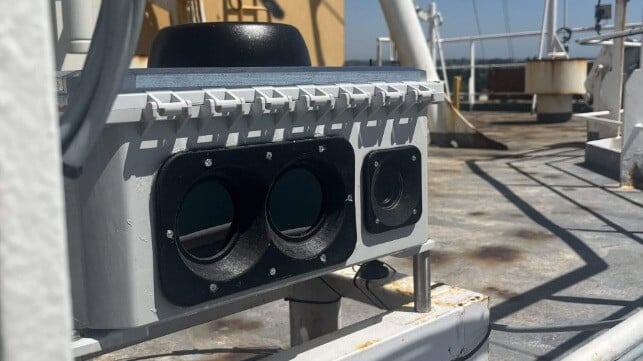Woods Hole and Matson Test Out Real-Time Whale Detection System

A new AI detection system may be able to help the shipping industry prevent collisions with whales. Researchers at Woods Hole Oceanographic Institution (WHOI) contend that ship strikes could decline drastically using a whale detection camera system for large commercial vessels. The cameras are mounted on a ship’s deck and use thermal imaging to detect a whale's body or spout, providing real-time information on their distance and bearing from a vessel. The aim is to provide the crew with enough warning to change course or speed.
The system, which uses thermal infrared cameras and is linked to an artificial intelligence (AI) algorithm, can be mounted on commercial ships, cruise ships and fishing vessels. Ship strikes cause the deaths of an estimated 20,000 whales around the world annually. In the U.S., approximately 80 endangered and threatened whales are struck each year off the West Coast, and more than a third of all North Atlantic right whale deaths in the Eastern U.S. can be attributed to ship collisions.
The system's AI has been trained on examples of waves, birds, vessels, and whales, and it is only supposed to send out alerts of probable whale detections for verification. All probable whale detections are reviewed by a human within 15 seconds and transmitted to the vessels' captains.
To guarantee its effectiveness, the human-in-the-loop verification ensures that captains never receive false alerts, thus avoiding alert fatigue and building trust and confidence in the whale detection technology. Unlike human observation from planes and boats, the system does not require ambient light, so the cameras can spot whales at all hours, further improving collision avoidance.
“A highly stabilized thermal imaging camera is mounted on a ship and monitors the surface of the water for whale surfacings and exhalations, or blows,” said Daniel Zitterbart, WHOI Associate Scientist in Applied Ocean Physics and Engineering. “If a whale blows, its thermal signature is recognized by the integrated AI, and also alerts vessel crews within seconds to the presence of whales up to several kilometers away, which is enough time for most vessels to slow down or change course.”
In developing the technology, WHOI has partnered with Matson Navigation, a Hawaii-based ocean transportation and logistics services company that has provided $1 million in funding. Matson has also availed three of its ships involved in domestic shipping to test the effectiveness of the system.
The system has been mounted on Manulani and Manoa - vessels that serve the Hawaii trade lane - and the Kodiak, which serves Alaska. Using the three containerships is strategic considering the waters off the coast of Hawaii and up along the U.S. west coast are home to up to 16 species of whales. Humpback whales migrate from summer feeding grounds in Alaska down to Hawaii. Killer whales, blue whales, gray whales, and other species also frequent the regions.
After three months of testing, the results are proving to be encouraging. On the Manulani alone, early 1,200 verified detections of whales and dolphins were recorded at ranges up to 3.5 nautical miles.
“This initial data is very exciting for our team, as it gives us real-world feedback on how well the thermal infrared system is performing on a large container vessel platform,” noted Zitterbart.
Matson, which has made significant adjustments to its operating schedule and vessel routing along the West Coast to avoid whale conservation areas, intends to expand the use of the system across its fleet. The researchers also hope that other liners will install the technology on vessels in order to reduce strikes and be a positive force in the protection of marine animals.
